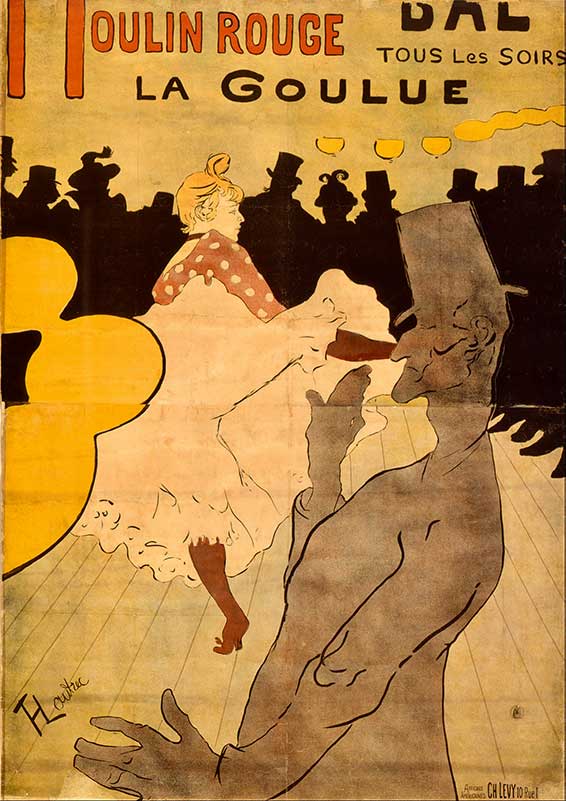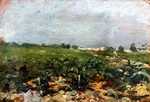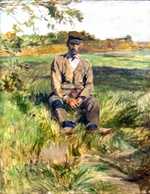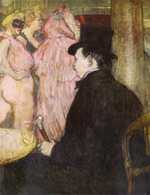1. Early Years
Born in November 1864 in Albi, France to an aristocratic family, Toulouse-Lautrec spent most of his childhood at one of the family estates named Château du Bosc.
During his teenage years, Toulouse-Lautrec used drawing and painting as an escape from his multitude of health issues, particularly the genetic disorder which caused him to break the bones in both of his legs.
Physical deformity
This disorder made him physically unable to pursue many activities. The effect was unfortunately permanent and he was known as an adult for having a stunted appearance, just five foot in height, with exceptionally short legs.
Toulouse-Lautrec walked with a cane throughout his life but spoke frankly of his handicaps declaring
“I will always be a thoroughbred hitched up to a rubbish cart”.
He was later described by his peers as a “sensitive, deeply affectionate man, conscious of his infirmity but wearing a mask of joviality and irony.”
He was once quoted joking about his alcoholism and deformities saying
“No, I’m not afraid of getting falling-down drunk…after all, I’m so close to the ground”.
Interestingly, Toulouse-Lautrec often painted figures in a way that did not show their legs, perhaps because of his own condition. This lack of fixed position added to the impression of movement in his paintings.
Toulouse-Lautrec and horses ...
Influenced by his first teacher, René Princeteau, a deaf-mute horse expert and family friend who painted sporting pictures, Toulouse-Lautrec’s first sketch subject was the horse. This interest continued throughout his career when, during his adult life, he painted horses at racetracks and circuses. Later, he would sketch ‘The Spanish Walk’ circus scene from memory in coloured chalk whilst recovering in an asylum.
Moving to Paris in 1882 after gaining his baccalaureate degree, Toulouse-Lautrec studied under Léon Bonnat. Bonnat was an academic painter who did not deviate from the rules. He found the Impressionists’ work clumsy and messy and disregarded Toulouse-Lautrec’s drawings as “atrocious”.
Toulouse-Lautrec's many teachers
Toulouse-Lautrec went on to study under Fernand Cormon, along with Émile Bernard and Vincent van Gogh, where he was given much more freedom to create expressive works.
His work was highly regarded by Cormon who, despite not using his drawings in the final edition, asked Toulouse-Lautrec to help him illustrate the works of Victor Hugo, a French Romantic writer known for Notre-Dame de Paris (more famously known as the Hunchback of Notre-Dame) and Les Misérables.
2. Henri Toulouse-Lautrec and the Impressionists
A pivotal moment in Toulouse-Lautrec’s career occurred while he was studying in Paris.
He began renting his own studio in Montmartre where he painted portraits of his friends and, along with his fellow students, began to rebel against the constraints of traditional artistic expression in France.
Toulouse-Lautrec and the impressionists
His most famous portraits from this time include one of his friend Vincent Van Gogh. This piece is a side profile of the artist sitting at a table with a glass of absinthe. The style and colours Toulouse-Lautrec used echo Van Gogh’s own paintings.
Inspired by the Impressionist artists, Toulouse-Lautrec began painting outside ‘en plein air’. He used the garden of Monsieur Forest, his neighbour and a retired photographer, as the setting to pose his models. One of these paintings named ‘The Streetwalker’ from 1890-91 depicts a prostitute and one of his favourite models whose nickname was La Casque d’Or. La Casque d’Or means Golden Helmet referring to the model’s wig. Her real name is unknown.
As well as Toulouse-Lautrec’s links to Van Gogh, the important influence of Impressionist Edgar Degas can also be found in the composition and subject matter of much of his work. He is quoted as saying,
"I don't belong to any school. I work in my corner. I admire Degas."
Work and play ...
As his career developed, Toulouse-Lautrec’s life and work quickly became focused on his social life.
He became captivated with capturing the vibrancy of the Bohemian culture he experienced while living in Montmartre. Named as one of the great artists of the Impressionist movement, his interest was in depicting reality rather than glamour. He aimed to show the true lives of the people he met and the places he frequented. As a result, his work provides a picture of the Montmartre nightlife culture that was otherwise rarely seen.
Woman before a mirror
This is perhaps most evident in his painting ‘Woman before a mirror’ from 1897 where he depicts a prostitute, naked except for her black stockings, looking at her body in the mirror*.* He paints her exactly as she is, opting for mainly reds and whites rather than more flattering tones and leaving her expression blurred by her reflection.

Method
Capturing movement differently to his predecessors, Toulouse-Lautrec used free hand lines and colours to give the impression of movement rather than being confined to the laws of perspective or portraying figures in a way that is anatomically correct.
He conveyed the personalities of entertainers by exaggerating their features and capturing their best-known characteristics rather than focussing on precise representation of their figures and form. His desire was to ‘depict the true and not the ideal’ which he demonstrated in his paintings and posters by using brushstrokes of colour to show the very essence of his subjects rather than recreating them in meticulous detail.
This dynamic style can be seen in a poster commissioned by his friend, Jane Avril, where Toulouse-Lautrec captures the spirit of her cabaret show. Avril is pictured mid-cancan kick while a double bass in the foreground is gripped by an unseen performer. Even the floor of the stage itself gives the impression of movement as it slants and slopes into the distance.
Often his medium also contributed to the realness of his pictures, as Toulouse-Lautrec preferred rough sketches or painting with thinned oil paints onto raw canvas or unprimed cardboard. He called this method ‘peinture à l’essence’, as opposed to the more refined, traditional methods of painting on a primed canvas.
Moulin Rouge
Toulouse-Lautrec was one of the first customers of the Moulin Rouge and frequently painted the nightclub made famous by the ‘chahut’ or cancan dance. He grew close to the owner of the infamous establishment and one of his paintings was even hung on the walls of the club.
The first of many paintings advertising the nightclub, ‘Moulin Rouge – La Goulue’ (1891) depicts Louise Weber, known as La Goulue (the glutton), wearing a red spotted top with red stockings. Weber can be seen practicing the cancan on a crowded dance floor and lifting her voluminous white skirts to reveal her bloomers.

A six-foot-tall poster of the painting was commissioned, in stark contrast to the curtseying, twirling girls shown on the previous billboards of Jules Chéret, giving rise to Toulouse-Lautrec’s career in printmaking.
Lithography
Using the lithography technique, Toulouse-Lautrec produced over 300 prints for magazines and books, song sheets and theatre programs along with albums and portfolios for collectors.
Lithography was invented in the late 18th century and immediately gained popularity with illustrators and artists as a means of replicating work, especially useful for the press. The rise of the colour lithograph in 1891 revolutionised advertising just at the time Toulouse-Lautrec began producing his striking posters.
Among his most famous works from this time was the poster ‘Divan Japonais’ (1892), an advert for the popular café-concert featuring two of his favourite entertainers.

Jane Avril is pictured watching the show alongs with Édouard Dujardin, a writer and regular at the nightclub, whilst Yvette Guilbert is performing. In his own Impressionist style, Toulouse-Lautrec painted Guilbert without her head but she is instantly recognisable by her tall, gaunt figure and elbow-length black gloves. The predominantly yellow and black poster is bold and striking and, one can imagine, would have been hard to ignore.
The ability to produce large posters in colour using the lithograph allowed Toulouse-Lautrec to experiment with different textures including ‘crachis’, a spattered ink technique. This method was used in his prints of Loïe Fuller which he reproduced in various coloured inks such as gold and silver creating a dazzling effect that captured her performance as he saw it at Folies Bergère. Fuller, an American performer, was particularly well known for her use of lights reflected in the billowing fabric of her dress which she moved with poles as she danced.
Japanese Art
Like many of the Impressionists, Toulouse-Lautrec was heavily influenced by his love for Japanese art which was introduced into France after the reopening of Japanese ports in 1855.
He collected ukiyo-e, woodblock prints, which became one of the main influences of his poster designs. The term ‘ukiyo’ means floating world and was used to describe the hedonistic lifestyle found in the Yoshiwara district of Edo, the village now known as the city Tokyo, much like the bohemian streets of Montmartre.
It is easy to see the inspiration drawn from the Japanese style reflected in the silhouettes, angles, shapes, colours and calligraphic lines Toulouse-Lautrec used in his work. However, it was not only the way in which he painted but the subjects themselves that were similar to those of the ukiyo-e artists.
... and Kabuki Theatre
Toulouse-Lautrec drew further inspiration from Kabuki theatre, a mixture of drama and dance, using bold colours and exaggerated characteristics to show the personality of a performer rather than focusing on the way they looked.

Kabuki theatre prints depicted an actor in costume and make up as their true self, showcasing the personality of the real person behind each character rather like a modern day ‘behind the scenes’ image. Similarly, Toulouse-Lautrec would paint performers as they were and as he knew them, to capture their very essence as a person rather than the character they played. For instance, he focused on the way people moved rather than their facial features.
Like Edgar Degas, Toulouse-Lautrec was inspired by the work of Utamaro who painted women in ‘green-houses’. However, in contrast to the eighteenth-century Japanese master, Toulouse-Lautrec did not try to make the women in his paintings elegant or refined, instead he portrayed the women of Montmartre as they were; raucous and mischievous, weary and lonely, flamboyant and shabby. Unlike many of his predecessors and artists of his time, Toulouse-Lautrec portrayed the women he painted and knew as independent, creative human beings.
This can be read as a sign of the times as relations between genders and classes were rapidly changing in Paris at the beginning of the nineteenth century. The women in his paintings were neither sexualised nor shown as weak or inferior but portrayed with sympathy and compassion.
Toulouse-Lautrec sadly died soon after Pablo Picasso moved to Paris, however the influence of his art can be found in their common interests of capturing nightlife, theatre, brothels and circuses, along with showing the sometimes harsh reality of a subject rather than glamourising it. Toulouse-Lautrec’s style also paved the way for the moves to Fauvism, the focus on emotion rather than form, and Cubism in the early 20th century.
3. Later career
Toulouse-Lautrec was well-known in the Parisian art scene by the 1890s.
He had an exhibition at the Salon des Indépendants while the largest exhibition of his work while he was alive was held at the Goupil Gallery in London in 1898.
During his later years Toulouse-Lautrec used the lithography technique to produce prints and posters. His most significant series of prints was named ‘Elles’, produced in 1896, which documented a brothel, depicting the prostitutes and their clients. This series aimed to show that the individuals involved shared the same traits as all human beings, regardless of their status in society.
Unfortunately, around the same time as this highly regarded series was produced, Toulouse-Lautrec’s health was rapidly deteriorating both physically and mentally. The lavish lifestyle which he enjoyed and was the subject of his work was not without its consequences.
After helping the cocktail rise to fame in the late 1890s, he unfortunately had a mental breakdown in 1899, due to his alcoholism and syphilis, when his mother left Paris without explanation. His mother decided to send Toulouse-Lautrec to an asylum in Neuilly-sur-Seine where he stayed for a few months.
During his time at the asylum, Toulouse-Lautrec produced work from memory based on circus scenes to prove his sanity. Works included a drawing titled ‘Au cirque: Entrèe en piste’ in which a horse and a circus performer are shown entering an arena for a performance, their shadows elongated to portray their fatigue.

Once again Toulouse-Lautrec’s art provided an escape as, upon leaving the asylum he said that he had
“brought his freedom with his drawings”.
Unfortunately, after leaving the asylum he began to drink heavily again and tragically died in 1901 at the age of just thirty-six.
4. Legacy
Despite his relatively short career, Toulouse-Lautrec has been widely influential to the work of artists decades later.
His work paved the way for the avant-garde art of the future and far outlived his physical life which was so tragically cut short. It has even been said that without Toulouse-Lautrec there would be no Andy Warhol.
The artist immortalised a vibrant time in the history of Parisian culture through his paintings and prints which are still in production today and instantly recognisable by the bold colours and striking images.
Toulouse-Lautrec is also well known for his quotes, which include:
"I have tried to do what is true and not ideal"
"Love is when the desire to be desired takes you so badly that you feel you could die of it."
Learn more about post-impressionism on:
- Our Van Gogh biography page.
- Our Paul Signac biography page.
- Our Georges Seurat biography page.

















